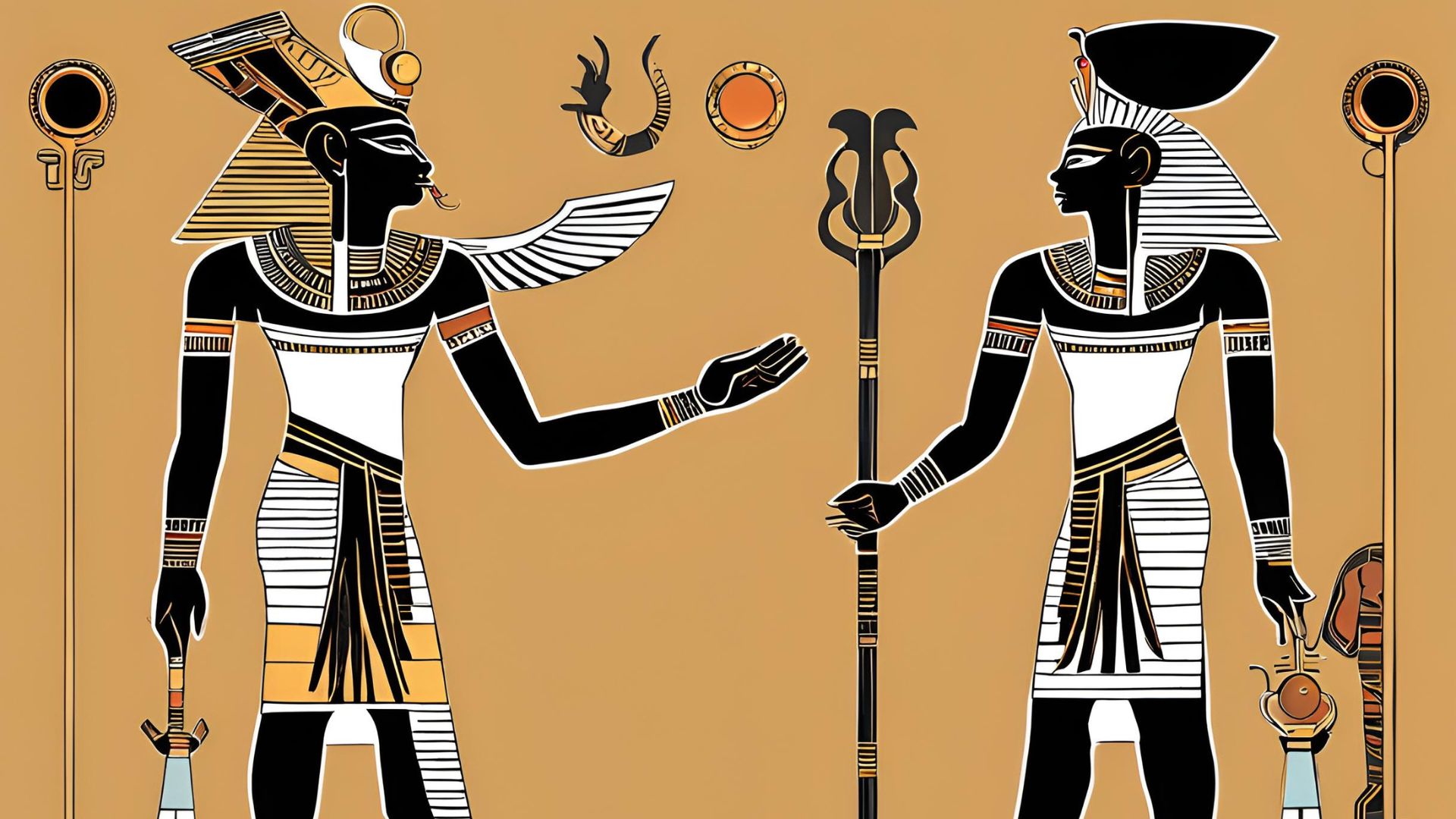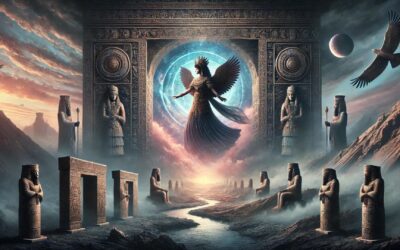The Tale of Osiris and Isis: A Love Story That Echoed Through Eternity
Gather around, dear friends, for a tale as old as time itself, a story that unfolded on the banks of the Nile River, amongst the towering pyramids and the golden sands of ancient Egypt. This is the tale of Osiris and Isis, two divine beings whose love transcended life and death.
Osiris, the benevolent king of Egypt, ruled with wisdom and compassion. He taught his people how to cultivate the land, brew beer, and live in harmony. His wife, Isis, was a powerful sorceress and a symbol of motherhood and fertility. Their love was the bedrock of Egyptian society, a source of inspiration and hope.
But their idyllic reign was not destined to last. Seth, Osiris’s envious brother, craved power and plotted to usurp the throne. In a cunning scheme, he tricked Osiris into a beautifully crafted coffin and cast it into the Nile, sending the beloved king to a watery grave.
Isis, devastated by the loss of her husband, embarked on a perilous quest to find his body. Her unwavering love and determination led her across the land, where she gathered the scattered pieces of Osiris’s corpse. With her magical powers, she reassembled him and briefly resurrected him, long enough to conceive their son, Horus.
Osiris, however, was not meant to remain in the mortal realm. He descended to the underworld, becoming the ruler of the afterlife, while Isis raised Horus in secret, preparing him to avenge his father and reclaim the throne.
This tale, etched in hieroglyphs on temple walls and passed down through generations, is more than just a myth. It’s a reflection of the human experience, a story that speaks to the universal themes of love, loss, betrayal, and the enduring power of hope.
Lessons from the Sands of Time
The myth of Osiris and Isis offers profound insights that resonate with us even today:
- Resilience in the Face of Adversity: Isis’s unwavering determination to find and resurrect Osiris teaches us the importance of perseverance and never giving up on hope, even in the darkest of times.
- The Power of Love: The love between Osiris and Isis transcended death itself. It reminds us that love is a powerful force that can overcome any obstacle.
- The Cycle of Life, Death, and Rebirth: Osiris’s journey to the underworld and Horus’s ascension to the throne symbolize the cyclical nature of life, death, and renewal.
- The Importance of Justice: Horus’s quest to avenge his father and restore balance to the kingdom speaks to the universal human desire for justice and fairness.
Your Invitation to Explore
The myth of Osiris and Isis is just one of countless fascinating tales from ancient Egypt. By delving into these stories, we connect with a rich cultural heritage and gain valuable insights into the human condition.
Your Call to Action:
Take a moment to reflect on the myths and legends that have shaped your own culture and beliefs. Explore the stories of your ancestors and discover the timeless wisdom they hold. Share these tales with others, and keep the flame of cultural heritage alive.
Let the story of Osiris and Isis inspire you to embrace the power of love, resilience, and hope in your own life. Remember, even in the face of adversity, there is always the possibility of renewal and rebirth.
Why Should You Care?
The myth of Osiris and Isis isn’t just an ancient story. It’s a window into:
- Understanding Human Nature: This tale reflects universal themes of love, loss, betrayal, and the enduring human spirit. These are emotions and experiences we all face, making the myth deeply relatable.
- Cultural Heritage: Egyptian mythology is a cornerstone of human civilization. Understanding it connects us to our past and the roots of our storytelling traditions.
- Spiritual Significance: For many, the myth holds spiritual meaning, offering insights into the afterlife, the cycle of life and death, and the importance of morality.
- Symbolism and Art: The story inspired countless works of art and literature, and its symbols still resonate in modern culture. Recognizing them enriches our understanding of the world around us.
Key Takeaways
- Love’s Resilience: The unwavering love between Osiris and Isis demonstrates the strength and endurance of love in the face of immense challenges.
- Hope in Grief: Isis’s tireless search for her husband’s body exemplifies the importance of hope and perseverance even in the deepest sorrow.
- The Cycle of Life: The myth mirrors the natural cycles of birth, death, and renewal, offering comfort and understanding of life’s transitions.
- Justice and Order: The eventual triumph of Horus over Seth reinforces the idea that justice and balance will ultimately prevail.
Keywords & Definitions
- Osiris: The Egyptian god of the afterlife, the underworld, and resurrection.
- Isis: The Egyptian goddess of magic, healing, motherhood, and fertility.
- Seth: The Egyptian god of chaos, violence, deserts, andstorms. Often depicted as the antagonist in myths.
- Horus: The son of Osiris and Isis, often depicted as a falcon or a falcon-headed man. He is the god of the sky, war, and protection.
- Underworld: In Egyptian mythology, the realm of the dead, ruled by Osiris.
- Resurrection: The act of returning to life after death, a central theme in the myth of Osiris.
- Hieroglyphics: The ancient Egyptian writing system using picture symbols.
- Mythology: A collection of myths, especially ones belonging to a particular religious or cultural tradition.
- Nile River: The lifeblood of ancient Egypt, central to their agriculture and beliefs.
- Pharaoh: The title of ancient Egyptian monarchs, often considered to be divine rulers.
Frequently Asked Questions
- Is the myth of Osiris and Isis based on real historical events? While the story is mythical, some scholars believe it may have been inspired by real events, such as the political struggles and power shifts within ancient Egyptian dynasties.
- How did the myth of Osiris and Isis influence ancient Egyptian culture? It profoundly impacted their beliefs about death, the afterlife, and the importance of preserving the body for resurrection. The myth also shaped their rituals and funerary practices.
- Are there other similar myths in different cultures? Yes, themes of death and resurrection, sibling rivalry, and the triumph of good over evil are common in many mythologies worldwide. For example, the Greek myth of Persephone and Hades shares similarities with the Osiris and Isis story.
Myth Buster
- Myth: Isis was a passive victim in the story.
- Reality: Isis is a powerful figure who actively seeks to restore her husband and protect her son. She embodies resilience, resourcefulness, and the fierce love of a mother.
Let’s Talk
- What aspects of the Osiris and Isis myth do you find most compelling or relatable?
- How does this myth compare to other stories of love and loss that you know?
- In what ways do you think myths and legends shape our understanding of the world and ourselves?
Feel free to share your thoughts and opinions in the comments below. Let’s delve deeper into the rich tapestry of mythology and explore the enduring power of these ancient tales.










0 Comments